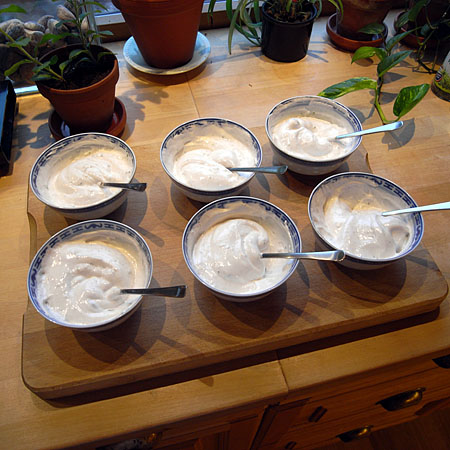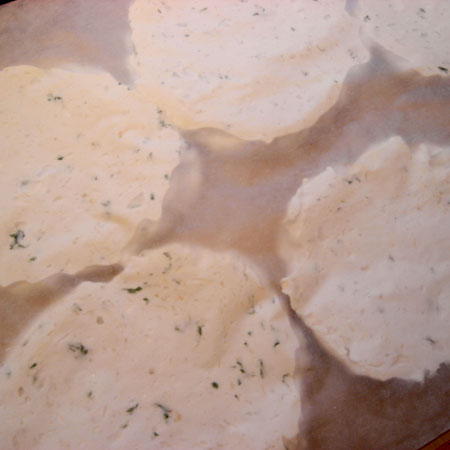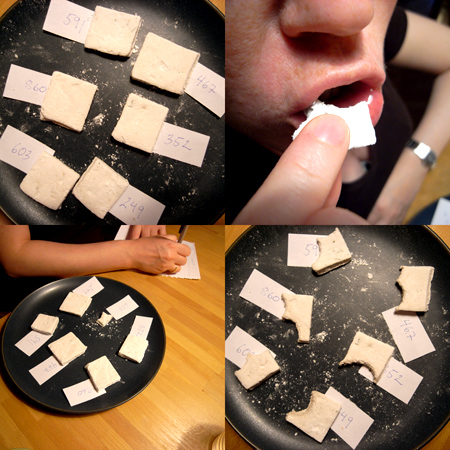
For TGRWT #2 I made banana marshmallows with parsley. The texture came out nice, but the initially fresh parsley flavour had become grassy/hay-like over night. The litterature I referred to last time suggested that the off-flavour is produced by oxidation of unsaturated fatty acids or polyenes. There are several strategies to avoid this. The first would be not to mince the parsley as finely as I did last time to avoid exposure to the air’s oxygen. If the oxidation is enzymatic, blanching would be helpful. And it would also be worthwhile to see if addition of lemon juice (vitamin C and citric acid, are both antioxidants) would have any effect (however, on second thought this would be strange since parsley already has a lot of vitamin C!). Mirko Junge commented last time that freeze dried parsley would possibly retain more of the freshness and he most generously provided me with several samples of freeze dried parsley. I decided to proceed with the following six types of parsley for my marshmallows:
- fresh parsley leaves, chopped to pieces of about 2-3 mm (picture above, left)
- parsley leaves, blanched for 30 sec, chopped to pieces of about 2-3 mm
- parsley leaves, sprinkled with lemon jucie, chopped to pieces of about 2-3 mm
- parsley leaves, blached for 30 sec, sprinkled with lemon juice, chopped to pieces of about 2-3 mm
- freeze dried parsley from Goutess (picture above, right)
- plain, dried parsley from my local store (picture above, front)
I used the same recipe as last time, but split the whipped sugar-gelatin-banana mixture into six different bowls before mixing with the parsley. I used approximately 0.6-0.8 g of fresh parsley for each of the entries 1-4. I tried to estimate the amount of dried parsley to use by eye, comparing with the amount of fresh leaves. The amount of dried parsley used was less than 0.1 g, so my balance was not of much help. The picture below might give you an idea.

Six different types of parsley were prepared immediately prior to mixing with the marshmallow base to minimize oxidation.

If the term ‘parallel cooking’ has not been invented yet, this might be good time to introduce it.

I let the marhsmallows set between two sheets of greased parchment paper.

Blind tasting of banana parsley marshmallows.
My wife helped me do a blind tasting to avoid any bias. The six marshmallow samples were each associated with a three digit code and presented on a plate to the taster. We both did two rounds each (A1/A2 and B1/B2) and the results are summarised in the table below. The scoring only describes the parsley flavour unless otherwise noted.
| Parsley used | A1 | A2 | B1 | B2 | Sum |
| Fresh parsley | 5 | 5 | 5 | 5 | 20 |
| Blanched parsley | 4/* | 1 | 2/* | 2 | 9 |
| Parlsey with lemon juice | 0 | 1 | 5 | 5 | 11 |
| Blanched parsley with lemon juice | 1 | 0/* | 2/- | 0/- | 3 |
| Freeze dried parsley | 4 | 2 | 2 | 2 | 10 |
| Dried parsley | 0/- | 0/- | 0 | 2 | 2 |
Legend:
5 fresh parsley, strong
4 fresh parsley, weak
2 grassy/hay-like parsley, weak
1 grassy/hay-like parsley, strong
0 neither fresh nor grassy, weak overall
– disagreeable
* banana dominates
I was quite surprised once I had decoded the score sheets. Fresh parsley cut into relatively large pieces gave a parsley flavour without any hints of grassy or hay-like off flavours! Blanching or treatment with lemon juice were both detrimental to the parsley flavour, and even more so when combined. The variation observed for could be a result of an uneven distribution of the parsley in the marshmallow (increased parsley flavour if you happen to chew a leaf). The freeze dried parsley didn’t do very well compared with fresh parsley, but outperformed the dried parsley from my local store which didn’t have much flavour at all. Both samples of dried parsley however were dominated by a grassy/hay-like flavour. I should add that the grassy/hay-like flavour in itself is not especially disagreeable, but it does not go very well together with the banana.
The result is interesting and perhaps a little counter intuitive. Generally one would say that a larger surface area (= finely chopped) would enhance the flavour release. This experiment however shows that this is not universally true, especially if the flavours can be oxidized. So next time you make banana parsley marshmallows remember that less chopping gives better parsley flavour.

chopping = damage to cell walls = degradation. Perhaps your larger pieces gave you a better aromatic oil retention without the loss or change due to cell wall damage.
I suggested before to use citric acid.. (btw citric acid is not vitamin C)
Citric acid = http://en.wikipedia.org/wiki/Citric_acid
Vitamin C = http://en.wikipedia.org/wiki/Vitamin_c
I wonder if it would have helped, especially re: pH buffering capacity.
I guess the conclusion isn’t THAT surprising – the larger surface area of the more finely cut parsley results in much easier access to the air which oxidizes it. On the other hand, maybe the parsley flavor comes through just fine by being released “on the spot” (or “in situ” as others would say). As such you’ve discovered that fresh parsley leaves serve excellently as a natural pro-flavor for parsley…
Nika,
I remember now that you suggested citric acid (and I’ve included it in the blogpost – thanks!). Since both vitamin C and citric acid can act as antioxidants, shouldn’t it be OK to combine them? Which buffering capacity were you refering to?
t,
That’s a way of putting it, yes! I agree that it’s perhaps not so surprising, at least not after the experiment has been done (isn’t it often like that?). And it causes me to wonder which herbs should be finely chopped and which ones should better be left whole. For instance, I have noticed that when mincing a herb (I think it was thyme), the initial thyme smell faded and it all smelled very “green”.
So how then should we treat herbs to maximize their flavour release, but minimize degradation of their flavour?
Good question. I don’t know. Maybe it’s then a compromise between flavour release and flavour degradation – which again then becomes an interesting function of the time frame you’re interested in. My guess (duh) is that it varies from herb to herb. Also, we could investigate further if you really need to cut the herbs at all? That is, are many of them perfectly capable of releasing the flavour upon chewing?
Enjoy reading your site. One interesting note on this conversation: at the Worlds of Flavor conference a couple of years ago at St. Helena, CA at the Food and Beverage Institute I sat in on a lecture on spices and herbs in which the venerable Harold McGee made a point of trying to steer people away from mincing herbs. Cutting into large pieces, as you discovered, is fine, but I guess there are actually reactions that take place between chemicals that are exposed to each other when the cells are cut open that create volatiles that are primarily “grassy/leafy” odors. Therefore, the more you cut, the more grassy flavor. At least that was my chef’s understanding of it!
[…] Lersch beschreibt in seinem Blog khymos einen lesenswerten Versuch, den Oxidationsprozess nach dem Schneiden/Hacken mit verschiedenen […]
So sorry that its taken me so long to reply!
Remember that Vitamin C is heat labile so if you are adding it to a hot solution, it will degrade in it’s function. (easily oxidized at 100 C). If the ambient pH is low, Vt C oxidation is somewhat minimized. http://www.paho.org/English/CFNI/cfni-caj37No304-art-3.pdf
Citric acid buffers pH so that your mix may not experience massive pH shifts as cell walls breakdown.